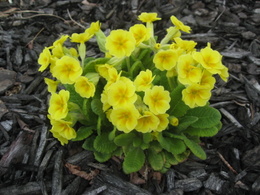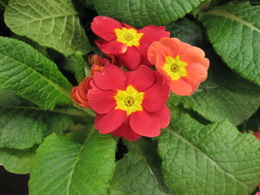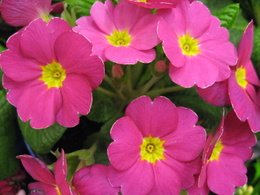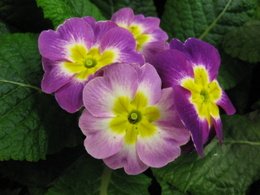Primrose Growing Guide
Primrose (Primula spp.) is a large family of perennial wildflowers native to areas around the Mediterranean Sea in wooded areas and will do well in USDA Zones 4 to 8.
Some of the familiar varieties you will find are the common primrose (Primula vulgaris), P. veris, P. auricular, P. elatior and P. japonica.
Most varieties have a low growth habit growing from a basal rosette with the flower on a 5 to 6-inch stalk with a typical height of 8 to 12-inches and spread 10 to 12-inches.
The blooms typically have a yellow center with bicolored petals in blue, red, yellow, white and many other shades.
They are one of the earliest flowers to bloom in the spring. Most are purchased to brighten the dining room table or other indoor location. You can place the nursery pot inside a decorative container, which does not need drainage holes. If the decorative container is too deep, add some small pebbles or marbles to the bottom to raise the primrose pot higher. After watering check to make sure that the primrose does not stand in water, which could cause the roots to rot.
It will continue to bloom for 4 to 6-weeks or more. The growers consider it a short-term houseplant that will be discarded after the blooms are finished.
After the last frost you can plant it in a lightly shaded location in a moist well drained soil. Astilbe and hosta are good companion plants.
In addition to being deer resistant a large mass planting of primrose simply looks beautiful in the early spring. It is not closely related to the evening primrose.
Starting From Seed
Primrose can be started indoors 6 to 8-weeks before your last expected frost date. Sow the primrose seeds in a sterile seed starting mix in cell packs or pots. Do not cover the seeds, because they need light to germinate. Press lightly into the soil and keep moist. Bottom watering is the easiest way to keep moist without disturbing the newly sown seeds. The primrose seeds should germinate in 3 to 4-weeks. They can be transplanted into individual pots after the true leaves appear.
To harden off your primrose plants put them outdoors when the temperature is in the 40s to the 50s. Put them in an area out of the direct sun and is sheltered from the wind for a few hours each day. Keep them watered and increase the time outdoors each day and allow them to get some direct sun. After about a week they can be left outdoors, but bring them indoors if frost threatens.
A cold frame is very useful in hardening off plants, making sure to open it up during the day or they could get burned from the heat of the hot sun. It can be closed at night if frost threatens and can protect your plants from animal damage. Hardening off prepares the plant for the outdoor environment and reduces transplant shock.
For more guidance our seed starting page will be helpful.
Soil Preparation
Plant your primrose in part sun to dappled shade in a nice loose well-drained garden soil. As soon as the soil is frost-free and can be worked, till the soil by digging down 8 to 12-inches turning the soil over with a garden fork. Remove any large rocks. The small pebbles remaining will do no harm and actually benefit the soil by adding some micronutrients to the soil. Primrose will do best in a slightly acid soil.
When to Plant
Primrose should be planted in the late spring after the last expected frost.
Planting Primrose
Plant them 8 to 12-inches apart or in groups of 3 or 5 in front of other taller plants. Dig a hole as deep as the pot and twice as wide. To the soil you just removed add the same amount of good garden soil so you have a nice blend of new and native soil.
Take the primrose out of the pot and gently loosen the root ball pulling away any roots that have grown in a circle around the pot.
Place the root ball in the hole with the growing crown of the primrose even with or an inch higher than the surrounding soil. Gently spread out the roots and back fill the hole around the root ball leaving a shallow depression around your plant. Fill the depression with water to settle the soil around the roots adding more soil if necessary and water again. Water daily tapering off as the primrose roots grow and get established.
Watering and Care
Primroses are low maintenance and easy to care for. All you need to do is add a layer of mulch to help retain moisture and keep out competing weeds. Your primrose should get an inch of water each week and during dry spells give some water to keep the soil moist. They usually do not need any fertilizer, but a light side dressing of organic fertilizer such as Espoma Flower-tone can be placed around the plant in the spring.
After the second or third year your primrose should be well established and have started to make side shoots which may start to crowd the mother plant. Right after blooming in the spring is a good time to divide your primrose. Water the plant heavily a day or two before so that the soil is soft.
One method is to gently loosen the soil around the plant and look for the side shoots and carefully cut them away from the mother plant. Another way is to dig up the entire mother plant and place it on a board or in a wheelbarrow. Loosen up the root ball and remove the side shoots from the mother plant.
These new primrose divisions can be replanted 6 to 12-inches apart in the same area to make a beautiful mass planting that will look beautiful next year. Water them and keep them moist as they get rooted in. They can be planted in another part of your garden or given to a friend to enjoy.
Diseases and Pests
Primrose is usually pest free but spider mites can be a problem if they are heat stressed. The quickest way to knock the population down is to use a garden hose nozzle to wash them off of the leaves and stems. Check every day and repeat to get rid of any you missed the day before. Using an organic insecticidal soap or neem oil is an effective way to control them as well.
There are several varieties of fungus that can cause leaf spot on primrose leaves. The fungus lives in the soil and shows up as brown spots on yellowing leaves. Removing affected leaves, mulching around the plant and increasing air circulation helps in controlling the problem.
Popular Varieties
Popular varieties:English cowslip (Primula veris), English primrose (Primula vulgaris), Drumstick primrose (Primula denticulata), Japanese primrose (Primula japonica).
Sources: Bluestone Perennials, Michigan Bulb, Select Seeds.
Gardening thought:
“Primroses, the Spring may love them;
Summer knows but little of them”.
William Wordsworth – English romantic poet (1770 – 1850)
Gardening Thought
“Primroses, the Spring may love them;
Summer knows but little of them”.
William Wordsworth – English romantic poet (1770 – 1850)
Garden Spikes newsletters give you timely information once or twice a month. Subscribe Free to the Garden Times newsletter below.
Your email address will only be used to send you a newsletter and will never be sold. You can unsubscribe at any time.




